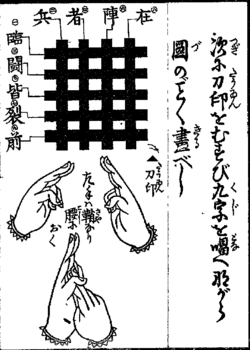Religion:Kuji-kiri
Kuji-kiri (九字切り lit. "nine symbolic cuts") is a practice of using hand gestures found today in Shugendō and Shingon Mikkyō.[1] [2]{{Page needed|date=December 2016} nd traditional schools ("ryūha") of Japanese martial arts including but not exclusive to schools that have ties with ninjutsu.
The Nine Cuts
- (臨) Rin – Power over oneself & other
- (兵) Pyō – Direction of energy
- (闘) Toh – Harmony with nature
- (者) Sha – Healing of oneself & others
- (皆) Kai – Premonition of danger
- (陣) Jin– Knowing the thoughts of others
- (列) Retsu – Dimension
- (在) Zai - Creation
- (前) Zen – Enlightenment
Religious symbolism and meanings
The Kuji-in were created from the gesture of both the hands. The left hand Taizokai represents a receptive valence, and the right hand Kongokai conveys an emitter valence. The Kuji Kiri performed with the right hand are to emphasize the cut of the ignorance of the Maya (illusion) (that is the deceptive sensory world) through the Sword of the Wisdom. In this way, according to the belief system of Shingon Mikkyo, one would come to create an opening in the daily world that would allow oneself to reach various states of consciousness. Derived from the Taoist dualism, Jaho could be seen as Yin, and Kobudera as Yang [citation needed].
See also
References
- ↑ Hosak, Mark; Lübeck, Walter; Grimm, Christine M. (2006). The Big Book of Reiki Symbols: The Spiritual Transition of Symbols and Mantras of the Usui System of Natural Healing (1st ed.). Twin Lakes, Wis.: Lotus Press. ISBN 0914955640.
- ↑ Okum, David (2008). Manga Martial Arts: Over 50 Basic Lessons for Drawing the World's Most Popular Fighting Style (1st ed.). Cincinnati, Ohio: Impact Books. ISBN 978-1600610295. https://archive.org/details/mangamartialarts0000okum.
External links


